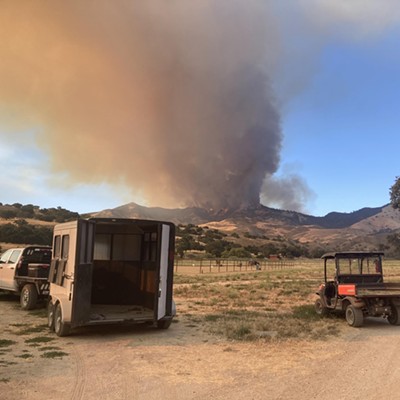
White and pink crystals glued to the gun’s grip shimmered in the morning light as she pulled the .45-caliber pistol from her purse.
Two sparkling hearts positioned precisely where this young woman clutches an undeniably lethal weapon create a curious paradox.
“It can kill somebody. This is not a toy,” she said about her Springfield XD semi-automatic pistol. “If you get shot with that, you die.”
She is an attractive, self-assured 30-something Santa Maria real estate agent who agreed to talk with the Sun on the condition of anonymity. We will call her Amanda*.
“There are too many stories of women being raped and too many stories of women being murdered,” Amanda said about her real estate colleagues nationwide who fall victim to violence. “I don’t want to be one of those statistics.”
Amanda bought the handgun 10 years ago after two alarming events happened just months apart.
When she was in her early 20s, a man broke into her home near Allan Hancock College while she slept, but he ran off when he heard a barking dog.
“It made me realize I didn’t have any way to protect myself,” she said.
The second incident could have been worse.
A bank asked her to inspect an abandoned house on Santa Maria’s northwest side to provide a broker price opinion.
She unlocked the front door, entered the home, and was surprised to find six teenage boys inside.
“They were in there smoking weed and drinking and partying, and here I am this 21-year-old girl walking in on this, with a bunch of these gangster-wannabe kids,” Amanda recalled.
As they started to surround her, Amanda realized no one else knew she was there. No one else would know if she was harmed. No one would come help her.
“My adrenaline starting pumping—I almost passed out, I was so nervous,” she recalled.
She turned around and ran out to her car. She decided then and there it was time to pack heat.
Within days, she was handing over $750 at a Santa Maria gun store for a .45-caliber Springfield XD, the same handgun that the Santa Maria Police Department issues to its officers.
After testing a wide range of firearms, Amanda said the Springfield felt the most comfortable in her hand. She liked the size of the grip and the feel of the slide, and most importantly she wanted the safety features.
“The reason I bought this gun is it lets me know if there’s a round in the chamber and if it’s cocked. It can’t accidently cock itself,” Amanda explained. “This gun is a lot safer because you have to physically cock it.
“It’s a big gun,” she said matter-of-factly. “I wanted something ‘real’ instead of a small gun where the bullet goes right through [an assailant’s] shoulder and they can still come at you.”
Over the years, she has trained with a variety of instructors and has logged hundreds of hours target shooting.
“It’s not like riding a bike,” she said. “You have to practice regularly.”
Amanda still visits empty, bank-owned properties for her job. Her handgun usually comes with her. When her pistol isn’t in her purse, it’s locked in her safe at home. As many as 15 times in recent years she has entered homes in Santa Maria she believed to be vacant, but were actually inhabited by squatters—people who unlawfully stay in an unoccupied house.
Amanda announces herself before entering such properties, at which time most squatters climb out of a window and run away. But some exhibit aggressive behavior.
“If they show a reluctance to leave—if they’re more likely to stand and leer or try to talk shit to me—at those times I’ll pull the gun out of my purse and I’ll just hold it in my hand where it’s visible, not in a threatening manner, and just have it there,” Amanda admitted. “And usually that’s just enough to get people to stop with the aggressive behavior and just go.
“I try to do everything as legally as I can and still be able to maintain it as a level of safety and protection,” she said. “If having [my pistol] in my hand is enough to diffuse the situation, I will do it every time. … It does lend me a level of security and comfort and strength.”
Real estate realities
According to national statistics, each year real estate professionals are robbed, assaulted, or even murdered while doing their job, showing homes to strangers.
In October of this year, a 29-year-old sales agent in Ohio was attacked and robbed by two masked men in a model home.
In 2011, a 27-year-old real estate agent was shot to death in Iowa during an open house.
A 67-year-old Ohio woman was strangled, robbed, and killed in 2010 when two men, targeting agents, set ablaze the house that she was showing.
In 2008 a 71-year-old Wisconsin grandmother and real estate agent was attacked and killed by a man posing as a prospective buyer.
In fact, 26 real estate and rental professionals were homicide victims in the workplace in 2012, according to the most current data from the Bureau of Labor Statistics, and hundreds more are victims of non-fatal attacks on the job each year.
Robbery is usually the motive and crimes like these usually happen in remote vacant homes, when the real estate professional is alone.
Following recent attacks this fall, the National Association of Realtors sent out an alert reminding its members to be careful and to access its numerous safety tips, webinars, and resources to help them stay safe at work.
Real estate agents in Santa Barbara County have had close calls over the past several years, but have escaped serious physical harm.
Santa Barbara County District Attorney Joyce Dudley told the Sun her office hasn’t prosecuted any such cases in recent memory.
“I know there are other areas that have had some horrible things happen,” said Shea Hutchinson, president of the Santa Maria Association of Realtors. “We’re lucky that nothing has taken place [here] for years of that nature.”
Unsolved realtor assault
Approximately 25 years ago, a real estate agent in Santa Maria was brutally attacked while selling a house. We’ll call her Susan*.
Susan’s friend and fellow real estate agent Pamela*, who asked the Sun not to reveal her identity, described the disturbing events.
While Susan was holding an open house at a home for sale in Santa Maria, a man slipped in unnoticed, hid upstairs, and once everyone else left, he called out to her. Susan went upstairs, where she was ambushed.
“He beat her, cracked her sternum—she had to have stitches in her head—cracked her knuckles, and tied her with cords. He was truly there to frighten her,” Pamela said.
“Clearly, he could have killed her if he opted to. She had to get herself together, untie herself, and go to a neighbor’s house for help,” she said. “We didn’t have cell phones then.”
Pamela said Susan was attacked in the same house where just a few weeks earlier a man had seriously beaten the homeowner with a bat.
Susan soon teamed up with Pamela for protection, never showing a home alone again.
There are steps that most real estate agents take to safeguard themselves, such as working in teams, asking clients for identification, and letting their offices know their whereabouts during the day.
One real estate agent told the Sun when she meets a new male client alone at a house, she photographs his car’s license plate and texts it to her significant other.
The Sun spoke with several real estate professionals; some carry a handgun, others keep guns at home, and more are considering buying a firearm.
A law enforcement perspective
Amanda doesn’t have a Carry a Concealed Weapon permit (CCW), which makes bringing her loaded gun to work, hidden in her purse, illegal.
Such a license is difficult to obtain in Santa Barbara County because Sheriff Bill Brown has a strict policy on concealed weapons.
According to Sheriff’s Department spokesperson Kelly Hoover, they “currently have 53 CCWs issued in Santa Barbara County. Out of those, five are issued to females.”
In most circumstances, if police catch an otherwise law-abiding citizen with a concealed firearm without a CCW, the crime is considered a misdemeanor.
Lompoc Police Sgt. Deanna Clement advises the public to leave it to the professionals to deal with perpetrators, rather than using a firearm for self-protection.
“The most important thing for people to do is to call 911 and get help on the way from people who are trained on how to use guns properly,” said Clement, who has been on the force in Lompoc for 23 years.
Nationwide, gun ownership is increasing rapidly, especially among women. A 2011 Gallup poll reported that 23 percent of American women personally own a gun—at least 20 million women. That’s up from 13 percent in 2005, an increase of 77 percent.
A 2013 Gallup poll found that the overwhelming reason Americans own a gun is for personal safety/protection (60 percent).
“I would say if anybody decided they wanted to own a gun for protection … learn how to use it properly,” Clement said. “Many times they shoot it and they have no idea of the power behind the gun; it will fall out of their hand, it will knock them backward if they’re shooting a shotgun or a rifle.
“To remain proficient you have to have to continue to shoot. You can’t just go out and shoot a gun one time and expect 10 years later to be in a threatening situation where you have to use it, and be able to fire and protect yourself,” she said. “You have to keep up on your training and you have to be shooting it often.”
Ready … aim … fire!
Employees of Tacti-Cool Guns & Gear in Santa Maria have trained thousands of local women and men on how to properly handle a firearm.
“The local demand from women around here is pretty incredible actually,” owner Brian Anton said. “We get everybody from housewives, school teachers, attorneys, doctors—all walks of life.”
Anton said half of his female students tell him they want a firearm for personal protection; others want to be familiar with a gun, if there’s already one in the home.
“They want to be able to educate their family, their kids, that guns are not toys, to have respect for them,” Anton explained. “A lot of parents, mothers especially, want to take the curiosity out of firearms with their families and at least be competent enough to explain why you shouldn’t mess with one.”
The store, located on Preisker Lane, specializes in tactical and self-defense firearms and accessories. It also has Santa Maria’s only indoor three-lane pistol and rifle shooting range, which is open to the public and frequented by the California Highway Patrol and other law enforcement agencies for training.
Anton, who previously worked in law enforcement, says a firearm should be the last choice in self-defense.
“Situational awareness is the main thing, especially if you’re a Realtor who’s going to show a home or something with a man that you’ve never met before,” Anton said. “Situational awareness: You have to listen to that little voice in the back of your head or the hairs on the back of your neck.
“There are other options before you get to a firearm; much like a police officer has a use-of-force continuum, any person should too. There are things like pepper spray, Tasers, stun guns. There are levels of self-defense before you get to a firearm,” he said.
“A man usually is going to be much bigger than a woman, so you have to consider that to be a lethal threat too,” he added. “So, depending on the situation, a firearm may be the thing that [women] need.”
Tacti-Cool offers a variety of firearms training classes, including a popular series of women’s classes with room for about 30.
“It’s usually full within 24 to 48 hours of us opening the registration,” Anton said.
Tacti-Cool starts registration for the next Women’s 101 firearms training series in January.
What homeowners should know
Longtime Central Coast real estate broker Bunny Maxim is aware that her profession can be dangerous. She has been in precarious situations herself, but she puts it into perspective.
“It’s a way of life. I enjoy it,” Maxim said. “If I were a long-haul truck driver, I’d have risks there, and so do many other professions. It takes awareness, it takes preparedness, and it takes luck.”
Maxim has a request of the home-buying public: “Don’t feel invaded when I’m asking for information.”
Maxim asks that when real estate agents request a name and phone number, clients give the information willingly. There’s a legitimate reason that she wants contact information—her protection.
“Tell us who you are so we know we’re dealing with a truly legitimate person and that it makes sense. Just understand and be forthcoming,” Maxim said. “I’m not going to pursue you like a creditor. That’s not how I build relationships.
“At the very minimum, [clients] need to understand [that] a little bit of information is essential before you ask someone to meet you as an anonymous person,” she added. “I think anybody can be in danger at any time. We just need to balance the odds−you need to improve the odds for yourself.”
*This name has been changed at request of the source.
Freelance journalist Wendy Thies Sell is a regular contributor to the Sun, writing the weekly Eats column. She can be contacted a [email protected].









